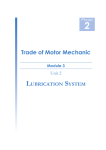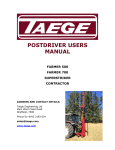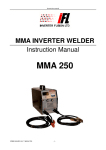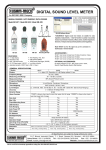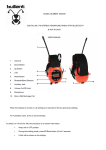Download Using a floor jack Objective: This workshop procedure guide
Transcript
Using a floor jack Workshop procedure guide Using a floor jack Objective: Lift and secure a vehicle with a floor jack and jack stands. This workshop procedure guide contains: • Step-by-step instructions for completing the workshop procedure. Personal safety: Whenever you perform a task in the workshop you must use personal protective clothing and equipment that is appropriate for the task and which conforms to your local safety regulations and policies. Among other items, this may include: • Work clothing - such as coveralls and steel-capped footwear. • Eye protection - such as safety glasses and face masks. • Ear protection - such as earmuffs and earplugs. • Hand protection – such as rubber gloves and barrier cream. • Respiratory equipment – such as face masks and valved respirators. If you are not certain what is appropriate or required, ask your supervisor. Safety check: • • • • • • • Make sure the jack and stands you are using are suitable for the job. Never lift a vehicle that is heavier than the jack’s rated capacity. Always use matched pairs of jack stands. Never support a vehicle on anything other than jack stands. Do not use wood or steel blocks to support the vehicle. They may slide or split under the weight of the vehicle. Do not use bricks to support the vehicle. They will shatter under the weight of the vehicle. Make sure that you understand and observe all legislative and personal safety procedures when carrying out the following tasks. If you are unsure of what these are, ask your supervisor. Points to note: • • • • • • • There are three types of workshop jacks: hydraulic, pneumatic and mechanical. Hydraulic and pneumatic jacks are the most common. They can be mounted on slides or on a wheeled trolley. The size of jack you use will be determined by the weight of the vehicle you want to lift. Most workshops will have a jack that has a lifting capacity of about 21⁄2 tons/tonnes. If the vehicle is heavier than that, or if the vehicle is loaded, you will need to use a jack with a larger lifting capacity. Always check the vehicle service manual or owner’s manual to determine the best position to support a vehicle. Some vehicles require special attachments to be fitted before they can be lifted. Do not jack or support a vehicle under any independent suspension components. They are not strong enough to support the weight of the vehicle. Make sure the vehicle is positioned on a firm level surface. Make sure the jack stands are in good condition before you use them to support the vehicle. If they are cracked or bent, they will not support the vehicle safely. © 2007 DVP Licensing Pty Ltd ABN: 64 699 557 126 20070730 page Using a floor jack Workshop procedure guide 1. Position the vehicle Position the vehicle on a flat, solid surface. Put the vehicle into first gear or park and set the emergency brake. Then place blocks in front of and behind the wheels that aren’t going to be raised off the ground. 2. Inspect the floor jack Before you try to use the jack, check for leaks in the hydraulic system. Check the pad, or saddle, and the wheels of the jack. They should rotate freely and show no signs of damage. Check the manufacturers’ label on the jack. The specifications will tell you the maximum load weight it will bear, so it must suit the vehicle you want to raise. © 2007 DVP Licensing Pty Ltd ABN: 64 699 557 126 20070730 page Using a floor jack Workshop procedure guide 3. Check the vehicle handbook Refer to the owner’s manual to find out where you can safely place the jack. This is usually a major point on the chassis, a cross member or axle unit. 4. Select the jack safety stands Before operating the jack, select two safety stands of the same type, suitable for the weight of the vehicle. Check the stands for any cracks, and if necessary lubricate the threaded adjusting post with a few drops of engine oil. Place one stand on each side of the vehicle at the same point. Adjust them so that they are both the same height, and high enough to slip under the vehicle once you’ve raised it. © 2007 DVP Licensing Pty Ltd ABN: 64 699 557 126 20070730 page Using a floor jack Workshop procedure guide 5. Position the jack Roll the jack under the vehicle, and make sure the pad, or saddle, is positioned correctly under the frame or cross member. Turn the valve on the top of the jack handle clockwise, and begin pumping the handle up and down until the jack pad touches and begins to lift the vehicle. 6. Check position of the jack Once the wheels lift off the floor, stop and check the placement of the jack pad under the vehicle to make sure there’s no danger of slipping. Double check the position of the wheel blocks to make sure they haven’t moved. If the vehicle is stable, continue lifting it until it’s at the height where you can safely work under it. © 2007 DVP Licensing Pty Ltd ABN: 64 699 557 126 20070730 page Using a floor jack Workshop procedure guide 7. Position the safety stands Slide the two jack safety stands underneath the vehicle. Make sure they’re positioned at a point that can support the weight. Both stands should be adjusted to the same height and placed as far apart as practical. 8. Lower the vehicle onto the stands Turn the valve on the jack handle counter-clockwise and gently lower the vehicle onto the stands. When the vehicle has settled onto the stands, lower the jack completely and remove it from under the vehicle. Repeat this process to lift the other end of the vehicle. Be aware that the vehicle is now supported on jack stands and will not be as stable as it would if the wheels were on the ground. When you’ve finished working under the vehicle, make sure you’ve removed all tools and equipment before you attempt to lower it. © 2007 DVP Licensing Pty Ltd ABN: 64 699 557 126 20070730 page Using a floor jack Workshop procedure guide 9. Raise the vehicle off the stands Use the jack to raise the vehicle off the safety stands. Slide out the safety stands from under the vehicle. 10. Lower the vehicle Turn the valve on the jack handle counter-clockwise very gently to lower the vehicle to the ground. Do not allow the vehicle to drop quickly or you may cause serious damage. Return the floor jack, the safety stands and the wheel wedges to their storage area before you continue working on the vehicle. © 2007 DVP Licensing Pty Ltd ABN: 64 699 557 126 20070730 page








